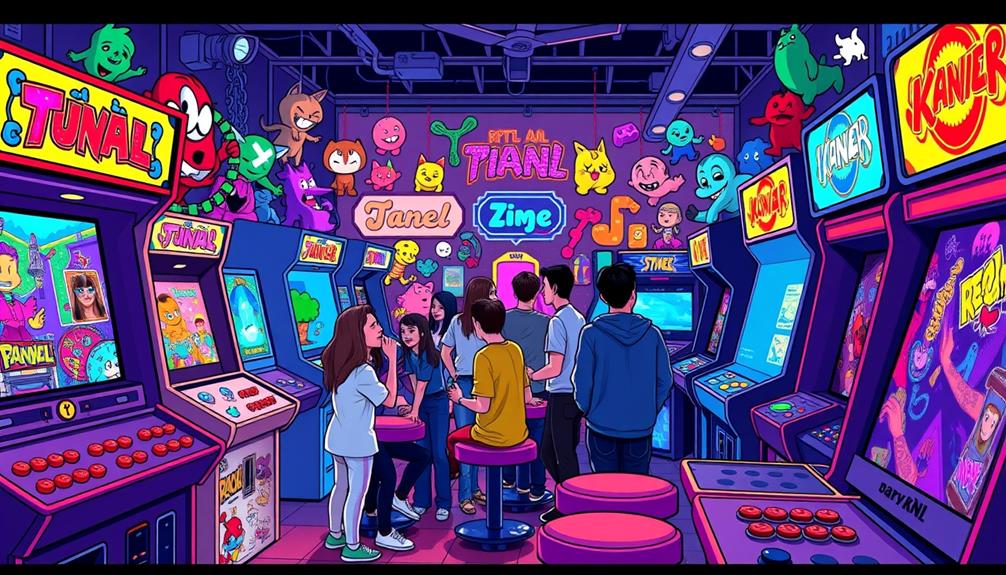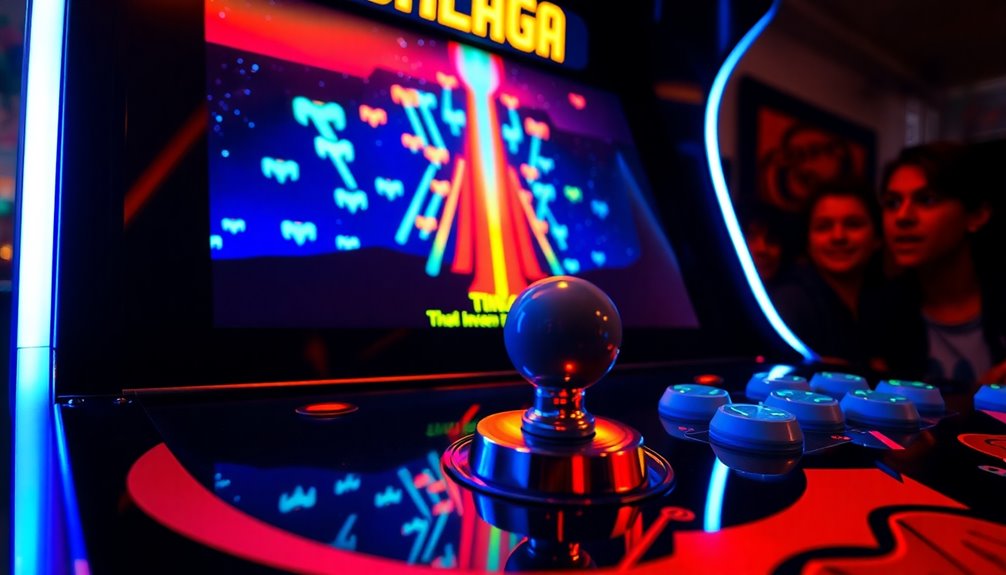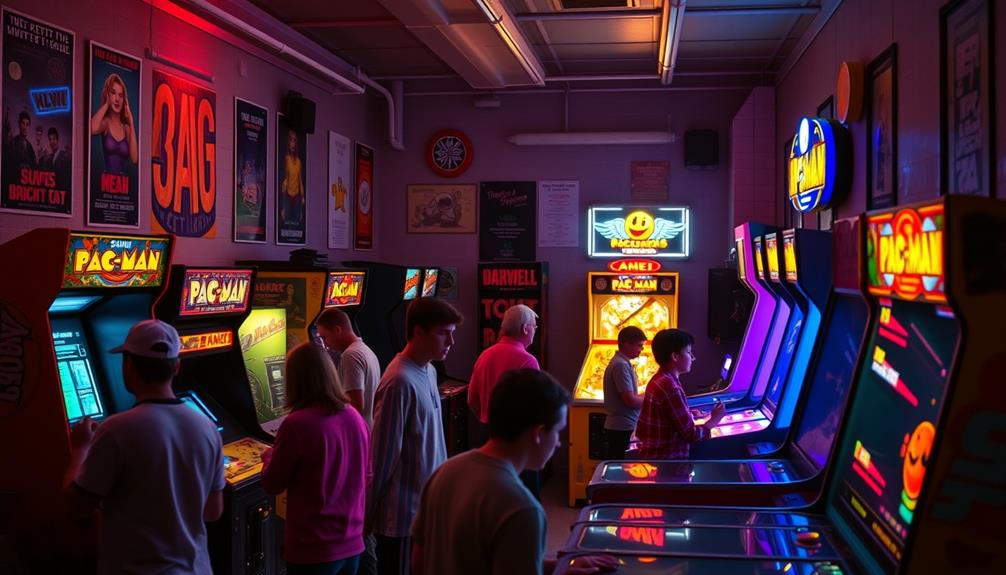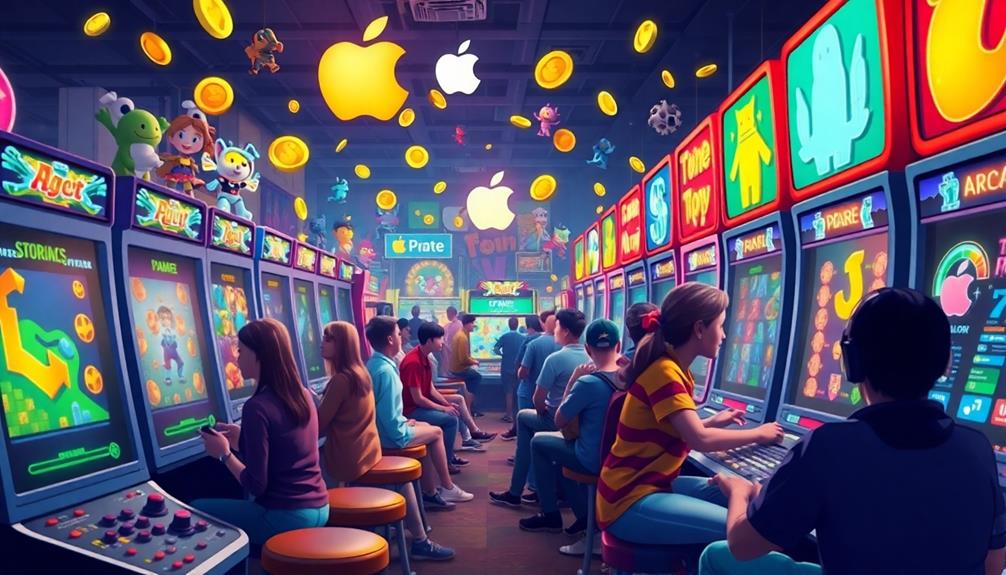Arcade games can be tough due to their intentional design to captivate players and encourage repeat plays. The game creators aimed to maximize coin insertion by incorporating challenging mechanics that put your skills to the test. With limited lives and instant-death scenarios, players are pushed to improve and learn from each attempt. Additionally, high score competitions offer a social validation aspect that motivates players to conquer tough gameplay for bragging rights among peers. This mix of challenge and competition ensures a memorable gaming experience. For those interested in how these elements influenced arcade culture, there is much to uncover. Many classic arcade games from the past are revered for their unique challenges and competitive spirit they created. Furthermore, part of the appeal of arcade games was their superior graphics compared to home gaming systems of that era. The link provided explains why arcade games boasted better graphics, as they were crafted to attract players and sustain their interest for extended periods. The fusion of demanding gameplay and impressive visuals solidified arcade games as a beloved form of entertainment in the 80s and 90s.
Key Takeaways
- Arcade games feature high difficulty levels to encourage repeated play, maximizing coin insertion and revenue for operators.
- The absence of save features and limited lives creates an endurance test that pushes players to improve through trial and error.
- One-hit death mechanics and fixed difficulty levels intensify the stakes, enhancing the challenge and emotional engagement of the gameplay.
- High score competition fosters social validation, with mastery of difficult mechanics serving as a badge of honor within gaming communities.
- Technical limitations in early games, such as low-resolution graphics and input delays, further complicated gameplay, contributing to the overall difficulty.
Historical Context of Arcade Games
In the late 1970s and early 1980s, arcade games emerged as a cultural phenomenon, engrossing players with their challenging gameplay. Developers focused on maximizing player engagement and coin insertion, leading to intentionally high difficulty levels. Many titles featured one-hit kill mechanics, ensuring that each failure prompted you to insert another quarter to continue. This design choice created a cycle of frustration and determination, compelling players to return time and again. The importance of keyword research also parallels this era, as developers identified player desires for challenge and competition.
The competitive nature of arcade gaming fueled a culture where achieving high scores became paramount. You often found yourself trying to outdo your friends, spurred on by the thrill of climbing the leaderboard.
However, technological limitations of early arcade hardware, including clunky controls and low-resolution graphics, added to the challenge. Precise movements became trickier, intensifying the demanding gameplay.
Moreover, the absence of save features or difficulty settings meant you'd to replay entire levels upon failure, increasing the overall challenge. This combination of high difficulty, a focus on player engagement, and the push for high scores transformed arcade games into a relentless yet enthralling experience that kept players coming back for more.
Economic Incentives Behind Difficulty
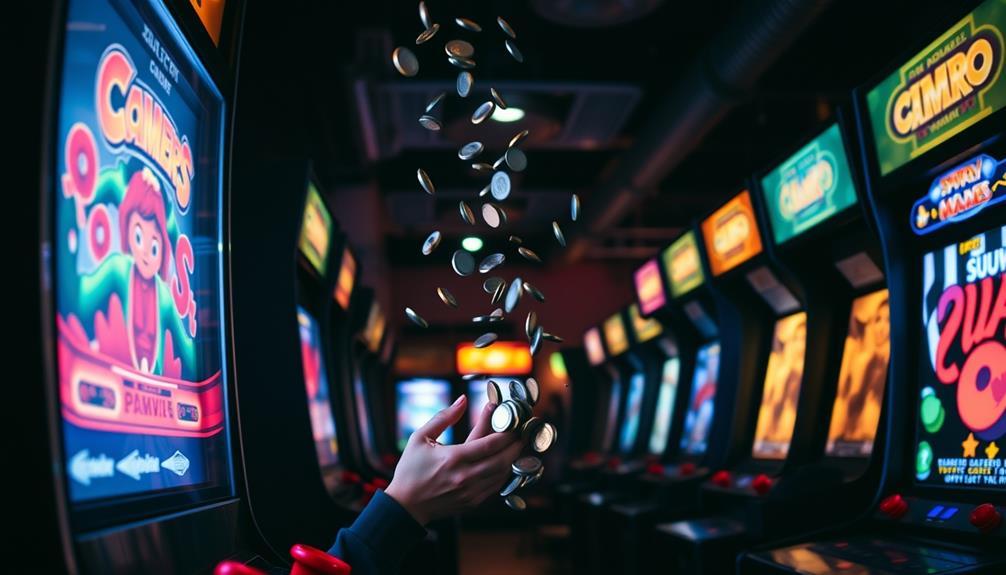
Arcade game designers recognized that high difficulty levels weren't just a gameplay choice; they were a strategic move to boost profits. By creating challenges that kept you engaged, they increased the likelihood of repeated play, maximizing coin insertion and revenue generation for operators. This economic model relied on your motivation to keep trying, even when the game got tough.
| Aspect | Impact on Players | Effect on Operators |
|---|---|---|
| High Challenge | Encourages persistence | Increases turnover |
| Difficulty Levels | Heightens engagement | Maximizes profitability |
| Adjustable Settings | Tailors experience | Balances player retention |
| Repeated Play | Boosts skill development | Enhances revenue streams |
For instance, games like Galaga earned around $0.50 every two minutes, showing how high difficulty levels directly fueled profitability. Many arcade operators utilized adjustable settings to fine-tune the challenge, ensuring you spent more time and money on the machines. This necessity for extended playtime justified higher game prices, driving developers to craft challenging experiences that keep you coming back for more.
Intentional Game Design Choices

High-stakes gameplay often defines the experience of classic arcade games, where intentional design choices shape the challenge you face. Developers crafted these games with high difficulty to encourage repeated play, maximizing coin insertion and revenue for arcade operators. This design philosophy mirrors the excitement found in best rated pinball machines, where the thrill of competition keeps players engaged.
One common mechanic is the one-hit death, which raises the stakes and compels you to invest more quarters for another shot at victory. Without save progress or difficulty settings, these games become an endurance test, demanding you to learn through trial and error. Every attempt teaches you something new, reinforcing the challenge and enhancing player engagement.
Economic factors like high game prices and limited storage pushed designers to create a challenging experience that compensated for fewer levels and content. Fixed difficulty levels rooted in arcade influences meant that the challenge was a cornerstone of the design.
This approach not only prolongs your engagement but also boosts profitability for operators, ensuring that you're always coming back for more. The intentional choices behind game design in arcade classics make each playthrough a memorable test of skill and perseverance.
High Score Competition Motivation

When you step up to an arcade machine, the drive for leaderboard dominance kicks in. Each score reflects not just your skill, but also gives you social validation among peers.
This competitive spirit is similar to how Jennifer Aniston and Brad Pitt maintain a friendly post-divorce connection, showcasing the importance of relationships in a competitive environment.
Competing for the top spot transforms the game into a shared experience, where every point counts and every victory is celebrated.
Drive for Leaderboard Dominance
Chasing leaderboard dominance fuels the competitive spirit of arcade gamers, pushing them to refine their skills and master challenging gameplay. Every quarter you drop into a classic title like Pac-Man or Donkey Kong isn't just about fun; it's an investment in achieving high scores that could secure your spot on the leaderboard.
The intricate scoring systems reward your hard work, enticing you to tackle difficult mechanics and level layouts. Engaging in this pursuit can be likened to the benefits found in music therapy integration, as both activities promote focus and emotional well-being through their immersive nature.
As you endeavor for mastery, you'll find that each personal best becomes a badge of honor within arcade communities. The thrill of surpassing your previous scores or outdoing your peers creates a competitive atmosphere that keeps you coming back for more.
You're not just playing for the sake of playing; you're in it to conquer the leaderboard and prove your skills. This relentless pursuit of high scores transforms gameplay into a shared experience, where every player is motivated to improve, encouraging repeated plays.
The excitement of competing for leaderboard dominance not only enhances your gaming experience but also solidifies your status among fellow gamers, making every victory feel that much sweeter.
Social Validation Through Scores
The pursuit of leaderboard dominance naturally leads to a desire for social validation through scores. When you input your initials on a high score board, it's more than just a number; it's a declaration of your skills and status within the gaming community.
In the arcade era, players thrived on competition, often spending hours mastering challenging mechanics to secure a top spot on the leaderboard. This cycle compelled players to invest more playtime, driven by the thrill of competing against others. Significantly, the essence of joy and nostalgia akin to the song Blue Skies and Lemonade resonates with the camaraderie found in arcade environments as friends gather to challenge each other.
Each coin dropped into the machine became a step toward mastery, as you sought to not just improve your score but also to outshine fellow players. The social validation you receive from achieving a high score is powerful, fueling your motivation to return and try again.
This culture of high score competition hasn't faded; it's alive in modern gaming communities, as online leaderboards and speedrunning events continue to celebrate achievements. Ultimately, the desire for recognition and mastery remains a strong force, driving you and countless others to engage with games that test your skills and resilience.
Mastery vs. Accessibility in Gameplay

In arcade games, players often face a fine line between mastery and accessibility. The difficulty tends to be high, compelling you to dive deep into gameplay mechanics without much guidance. Early arcade titles didn't offer difficulty settings or tutorials, so you'd to rely on trial and error to develop your player skill. This lack of accessibility made triumphs feel even sweeter as you mastered punishing gameplay that often required extensive memorization.
In addition, the immersive experiences found in unique party options enhance the enjoyment similar to that of arcade challenges, as both require engagement and participation.
The concept of "Nintendo Hard" emerged from this environment, where overcoming challenges became a badge of honor. Limited lives meant that each attempt was a high-stakes affair, pushing you to improve with every playthrough. You might get frustrated, but that's part of the thrill.
Modern interpretations of arcade difficulty, like in indie games such as Shovel Knight and Super Meat Boy, aim to balance mastery with accessibility. They recognize that while hardcore gamers appreciate tough challenges, casual players also want to enjoy the experience. By refining gameplay mechanics, these games invite players of all skill levels to engage, ensuring that the spirit of arcade games continues to thrive.
Psychological Engagement Techniques
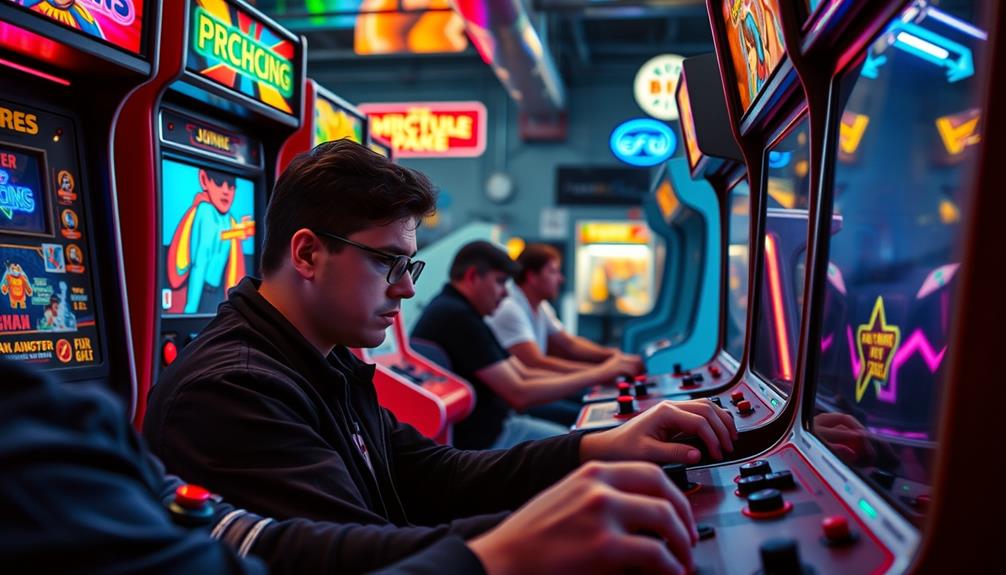
Arcade games masterfully employ various psychological engagement techniques to captivate players and keep them returning for more. These games leverage psychological triggers like the thrill of competition and the desire for improvement, motivating you to invest time and money into mastering difficult challenges. The use of instant death mechanics creates a sense of urgency, heightening emotional engagement as you push through repeated failures.
Additionally, much like the way backyard transformation essentials enhance outdoor spaces for enjoyment, these games transform simple play into an addictive experience.
Game designers understand that your attachment to a game often stems from its addictive nature. By incorporating elements of surprise and frustration, they stimulate your desire to overcome obstacles, leading to increased satisfaction when you succeed. Familiarity with game mechanics reinforces this bond, making you more likely to return for another round.
To maintain your interest, arcade games feature escalating difficulty and well-placed rewards. Each time you fail, the anticipation of improvement drives you to try again, creating a loop of challenge and reward.
This cycle guarantees that even when you face setbacks, the lure of mastering the game and achieving your goals keeps you engaged. Ultimately, these techniques create a compelling experience that hooks you in, making it hard to walk away from the arcade machine.
Technical Limitations of Early Games

Despite their charm, early games faced significant technical limitations that affected gameplay. These constraints made it challenging for you to enjoy a seamless gaming experience. Low-resolution graphics often blurred the line between obstacles and safe spaces, making it tough to gauge distances accurately. Input delays from hardware limitations hindered responsive character movement, resulting in frustrating moments when timing was essential.
Here's a breakdown of some of these challenges:
| Limitation | Impact on Gameplay | Player Experience |
|---|---|---|
| Low-resolution graphics | Hard to see hazards and gauge distance | Increased risk of unexpected deaths |
| Input delays | Unresponsive controls | Frustrating when quick reflexes needed |
| Glitches | Bugs remained unfixed | Heightened difficulty and annoyance |
| Limited lives/continues | Restarting upon losing all lives | Amplified perceived challenge |
These factors often led to steep learning curves, requiring you to rely on trial and error to master the mechanics. Punishing gameplay was common, as you found yourself restarting from the beginning with limited resources. Overall, these technical limitations shaped the challenging nature of early arcade games, making them both memorable and intimidating.
Cultural Impact of Arcade Challenges
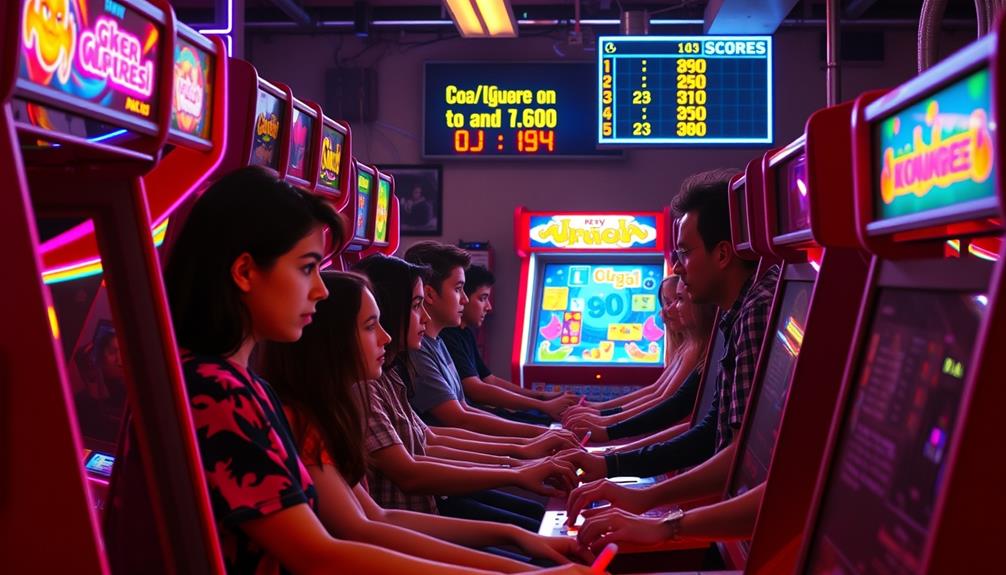
The technical challenges of early arcade games not only shaped gameplay but also laid the groundwork for a vibrant cultural phenomenon. The high difficulty levels of arcade games encouraged you to keep inserting coins, as exemplified by classics like Galaga, which raked in $0.50 every two minutes.
This relentless challenge fostered a competitive culture among players, leading to community engagement through high score competitions and tournaments that became social hubs in the 1980s. The evolution of gaming hardware, reflected in the advancements seen in pinball machines, contributed to the immersive experiences that players sought.
The term "Nintendo Hard" emerged, symbolizing the difficult gameplay that defined many experiences in both retro and modern gaming. You can't help but feel a sense of achievement as you conquer these challenges, reinforcing the idea that mastery over tough mechanics could elevate your social status among peers.
As you immerse yourself in online discussions and events celebrating the allure of overcoming difficult gameplay, it's clear that the cultural impact of these arcade challenges endures. Gamers share experiences and strategies, highlighting how the difficulty of arcade games continues to resonate, drawing you into a community that values perseverance and skill in the world of retro gaming.
Evolution of Difficulty in Gaming
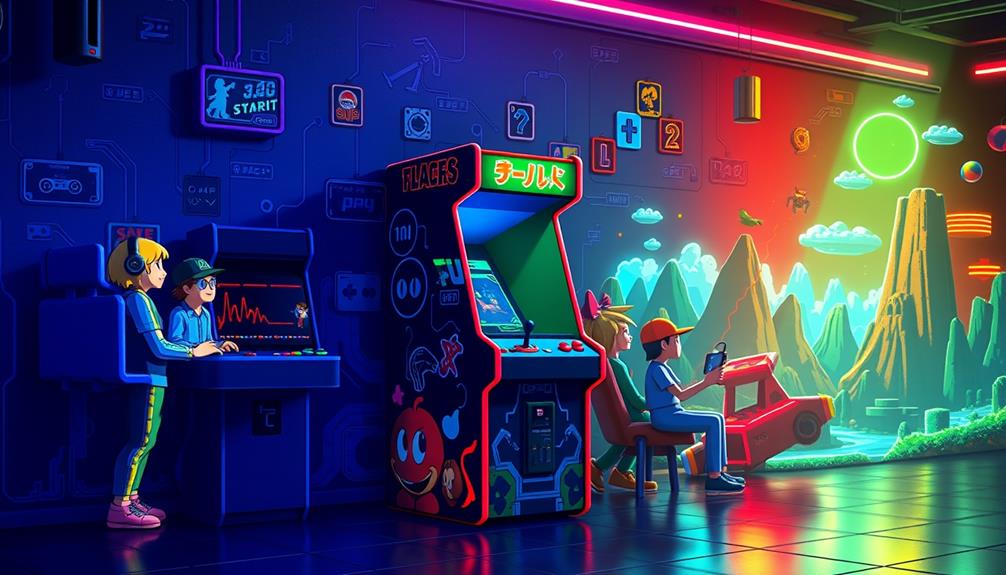
When you look back at early arcade games, you'll notice they were crafted with a clear purpose: to keep you coming back for more.
Designers intentionally ramped up the difficulty to maximize your coin insertion, often leaving you with limited lives and steep challenges. This approach not only guaranteed a steady stream of revenue but also fostered a competitive environment that encouraged players to improve their skills and strategies, much like the data-driven strategies that yield measurable results today.
This revenue-driven approach shaped how difficulty evolved in gaming, influencing both past and modern titles.
Historical Design Practices
Early arcade games captivated players with their notoriously high difficulty levels, intentionally designed to keep you coming back for more. Game designers crafted these experiences with the economic model in mind, maximizing coin insertion by ensuring player turnover. This approach reflects the principles of design thinking, emphasizing user-centric solutions that enhance engagement.
You faced punishing challenges, often with limited lives and single-hit deaths, which elevated the stakes and created an urgency that demanded skill and patience. Without save progress or adjustable difficulty, each session turned into an endurance test. The thrill of trying to achieve high scores kept you engaged, as every quarter spent was a chance to conquer the next challenging level. This approach wasn't just about fun; it was a strategic decision to encourage repeated play.
Designers, often with arcade backgrounds, focused on creating immersive experiences that kept you hooked. Every time you faced a tough obstacle, the satisfaction of overcoming it made you enthusiastic to insert another coin.
These historical design practices shaped the way arcade games challenged you, ensuring that difficulty became a core aspect of the gaming experience. In a world without save features, your persistence turned into a badge of honor, and the cycle of play continued.
Revenue-Driven Difficulty Choices
Arcade games didn't just challenge players for the thrill; they were meticulously designed to drive revenue by encouraging repeated play. Developers understood that by increasing difficulty levels, they could maximize coin consumption. Games like Galaga, which raked in $0.50 every two minutes, exemplified this revenue-driven approach.
Consider the following strategies that shaped arcade gameplay:
- One-hit kills to heighten tension
- Limited lives extending gameplay sessions
- Default hard settings in lightgun games for profitability
- Fewer levels, but with demanding mechanics for sustained interest
- Influences on modern game design to evoke nostalgia
This economic model relied on player engagement and turnover. High difficulty kept players coming back, enthusiastic to conquer challenges, while simultaneously prompting them to spend more on attempts.
Even with the limited storage capacity of arcade machines, developers creatively crafted challenging mechanics to maintain interest.
Today, many modern games echo this legacy, embracing challenging gameplay to capture the same excitement and mastery that drove arcade success.
Fundamentally, the evolution of difficulty in gaming remains tightly woven with the quest for revenue, shaping experiences that keep players hooked.
Frequently Asked Questions
Why Are Arcade Games so Difficult?
Arcade games challenge you with tough mechanics and limited lives, pushing you to improve. You face hidden traps and complex levels, creating urgency and a steep learning curve that keeps you coming back for more.
What Is the Hardest Arcade Game?
When you face the hardest arcade game, you're battling relentless foes, maneuvering tricky levels, and mastering unique mechanics. Titles like "Magician Lord," "Ikaruga," and "Ninja Gaiden" challenge your skills and test your patience.
How Do You Win Arcade Games Easily?
To win arcade games easily, practice regularly, utilize continues wisely, learn techniques, focus on high-scoring moves, and observe skilled players. By doing this, you'll improve your skills and enhance your chances of success.
Are Arcade Games Good for Your Brain?
Arcade games are like brain workouts, sharpening your reflexes and boosting problem-solving skills. You'll find your focus sharpened and your mental flexibility enhanced, all while having fun overcoming challenges. They're definitely good for your brain!
Conclusion
In the vibrant world of arcade games, difficulty isn't just a hurdle—it's a thrilling challenge that keeps you coming back for more. While mastering each level demands skill and patience, the rush of triumph when you finally conquer a tough boss makes every bit of struggle worthwhile. This delicate balance between frustration and exhilaration defines the arcade experience, turning fleeting moments of defeat into lasting memories of victory. Embracing the challenge transforms gaming from a mere pastime into an exhilarating journey.


